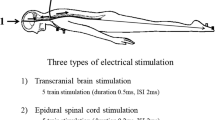Summary
The authors have attempted to establish a practical technique for recording human and animal spinal cord action potentials evoked by epidural electrical stimulation and to correlate the findings with both clinically occurring and experimentally produced spinal cord lesions.
Examples of the clinical and per-operative applications of the technique are described.
Résumé
Les auteurs ont cherché à mettre au point une technique usuelle d'enregistrement, chez l'homme et chez l'animal, du potentiel d'action de la moelle provoqué par une stimulation électrique épidurale. Ils ont également cherché à mettre leurs résultats en corrélation avec des lésions médullaires observées en clinique et d'autres réalisées expérimentalement.
Description de quelques exemples d'application clinique et peropératoire de cette technique.
Similar content being viewed by others
References
Pool, J. L.: Electrospinogram (ESG). J. Neurosurg. 3, 192 (1946)
Sawa, H.: Spontaneous electrical activities obtained from human cord. Folia Psychiatr. Neurol. Jpn. 2, 165 (1947)
Magladery, J. W., et al.: Electrophysiological studies of nerve and reflex activity on man. IV The two-neurone reflex and identification of certain action potentials from spinal roots and cord. Bull. John Hopkins Hosp. 88, 499 (1951)
Stark, M. B.: Potentials of human spinal cord in normal and diseased states. Fed. Proc. Trans. Suppl. 22, 1094 (1963)
Puletti, F., et al.: Single neurone activity in posterior columns of the human spinal cord. J. Neurosurg. 27, 255 (1967)
Shimoji, K., et al.: Epidural recording of spinal electrogram in man. Electroencephalogr. Clin. Neurophysiol. 30, 236 (1971)
Kurokawa, T.: Spinal cord action potentials evoked by epidural stimulation of cord — A report of human and animal record. Jpn. J. Electroencephalogr. Electromyogr. 1, 64 (1972)
Imai, T., et al.: Evoked spinal cord action potentials observed in epidural space with direct stimulation on cord. Jpn. J. Electroencephalogr. Electromyogr. 1, 196 (1972) (in Japanese)
Tamaki, T., et al.: Spinal cord action potential as a monitoring method. (in Japanese) Jpn. J. Electroencephalogr. Electromyogr. 1, 196 (1972)
10. Ertekin, C.: Human evoked electrospinogram. In: New Developments in Electromyography and Clinical Neurophysiology. Vol. 2, pp. 344. Edited by Desmedt, J. E. 1973
Cracco, R. Q.: Spinal evoked response; peripheral nerve stimulation in man. Electroencephalogr. Clin. Neurophysiol. 35, 379 (1973)
Tsubokawa, T., et al.: Clinical evaluation of spinal electrogram in spinal cord injury (in Japanese). Clin. Encephalogr. (Osaka) 16, 398 (1974)
Häggqvist, G.: Analyse der Fasererteilung in einem Rückenmarksverschnitt (Th3). Z. Mikrosk. Anat. Forsch. 39, 1 (1936)
Shealy, C. N., et al.: Electrical inhibition of pain by stimulation of the dorsal column: Preliminary clinical report. Anesth. Analg. Curr. Res. 46, 486 (1967)
Kano, T., et al.: The patterns of evoked spinal electrogram in man (in Japanese). Clin. Physiol. 1, 559 (1971)
McDonald, W. I., et al.: The effects of experimental demyelinization on conduction in central nervous system. Brain 93, 583 (1970)
Kurokawa, T., et al.: Evoked spinal cord action potential in epidural space (II). Report in the 2nd Congress of Japan Society of Electroencephalography and Electromyography 1972
Deecke, L., et al.: Neurophysiological assessment of afferent and efferent conduction in the injured spinal cord of monkeys. J. Neurosurg. 39, 65 (1973)
Croft, T. J., et al.: Reversible spinal cord trauma: A model for electrical monitoring. J. Neurosurg. 36, 402 (1972)
Hardy, R. W., Jr., et al.: Follow-up report. Experimental and clinical studies in spinal cod monitoring. J. Bone Joint Surg. 55-A, 435 (1973)
Yamanaka, T.: Electrophysiological findings in myelopathy. In: Asueno Seikeigeka Tenbo '73–'74. P. 389. Edited by Itami, Y. et al. Tokyo: Kanehara 1974
Author information
Authors and Affiliations
Rights and permissions
About this article
Cite this article
Tsuyama, N., Tsuzuki, N., Kurokawa, T. et al. Clinical application of spinal cord action potential measurement. International Orthopaedics 2, 39–46 (1978). https://doi.org/10.1007/BF00266001
Issue Date:
DOI: https://doi.org/10.1007/BF00266001




